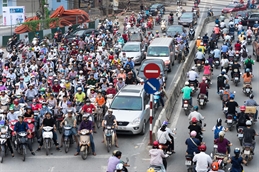
Solutions to the increasingly complex problems of last-mile delivery were outlined during the Last Mile ASEAN Conference and Expo 2019 in Bangkok on September 26 and 27.
One of the more challenging parts of the supply chain – one where consumers want things more and more quickly – last mile is seeing an industry norm of 30 minutes emerging. (It might get even tougher: someone did say 20 minutes at one point, and no one seemed to be that surprised.)
Technology is at hand to help, but it needs to be the right sort, pointed out Benjamin Dietrich, global sales business manager, e-commerce and fashion, for material-handling solutions specialist Interroll. New technology is already here, but it only works when clear thought is given in advance to last-mile requirements, he said. The technology must also be competitive.
Among the examples, he gave: single orders not being suitable for last-mile and zone-to-zone picking being of limited use for e-commerce logistics. Robotic transportation, he added, despite the high initial cost, is very scalable – always an important consideration – as well as flexible and “suited to high throughput.”
One of the other uses of tech comes at a different point in the process, but it also helps lessen what Bob Chua, founder and CEO of Malaysia-based luxury fashion e-commerce firm BlinQ called the “huge, huge issue of returns.”
BlinQ’s strategy has been to work with the companies whose products it sells to minimize returns by helping consumers make better decisions by virtual reality to give them more information on the product especially how it, and alternatives, will look. “We actually augment their entire catalogue,” Chua said of its clients.
One of the other big responses outlined –with a lot of support across the industry – is rethinking location and numbers of physical stores, warehouses and depots to be nearer to customers.
One of the leaders here is IKEA, which is moving towards a smaller store format to be “closer to consumers,” Jaap Doornbos, the Swedish company’s retail director deputy for Southeast Asia told the Conference.
Similarly, Walmart is moving to 10 small depots around Tokyo to get closer to the city’s nearly 14 million residents and to solve the problem of high land costs in urban Japan, which makes large facilities such as mega-warehouses problematic. Even then, Walmart aims not to rely on these facilities.
“We try to minimize the function of the depot,” Yoshihito Sasaki, vice president, operational excellence, eCommerce, for Walmart in Japan, said.
Another take on this came from Indonesia, where stores, rather than being seen as buildings can become fulfilment centres. “Leverage the assets you have,” was the advice of Sreekanth Chetlur, head of e-commerce and omnichannel at Matahari Department Stores.
This might sound out-of-sync with the times, but Asia is still having a brick and mortar building boom. Matahari’s 160 stores spread across 75 cities in Indonesia were, Chetlur added, its “biggest advantage.”
There is a growing awareness of the problems the last mile has in ASEAN countries. Those problems seem likely to become more acute as e-commerce creates millions of more impatient consumers.
E-commerce is expected to be worth some US$240 billion in 2025. However, that very real growth brings with it consumer demands that are growing just as quickly. The consumer mantra in the age of e-commerce was summed up as expecting a specific time, being able to see it 100% down the line, not wanting to pay and wanting shipments delivered at the first attempt.
This is on top of a raft of already-there problems. Some 70% of last-mile deliveries are in high-density urban areas where congestion is a way of life. The variety of goods being shifted creates the need for multiple modes of transport, which adds to the complexity.
Added to this, some cities have very specific rules designed for other purposes such as easing congestion and pollution, which just add to the brew of factors deliverers have to deal with. Mentioned at the conference was Jakarta’s odd and even days rule and Manila with is specific hours rule – something which is also a problem in Yangon.
Then, there is the problem of what was diplomatically referred to as “fuzzy addresses.” This was more politely rebranded as the difficulty of working with non-standard address, which is written differently in different parts of Asia.
That wasn’t enough for some though. “You expect machines to understand this when your warehouse manager doesn’t even read?” was one the view of one frustrated attendee.
The other big problem mentioned across the conference was the issue of cash on delivery (COD) sales. Southeast Asia, with the exception of Singapore, is still very much a cash society, suggesting the last mile services it has to create will need to be different to the Western template it has adopted so far and the Chinese model being pioneered by Alibaba in Hangzhou.
By Michael Mackey
Southeast Asia Correspondent | Bangkok




